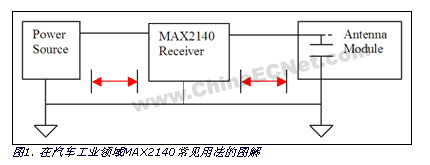Design of Protection Circuit for Internal ESD Diode of MAX2140
|
When a MAX2140 SDARS receiver is hot-plugged (plugged in or disconnected), it may invalidate its internal electrostatic discharge (ESD) protection diode, which is not the standard operation of the device. However, this situation can occur in many applications, especially in the automotive industry, where hot-plug operations are often performed. This paper analyses the possible causes of ESD diode failure due to hot-plug operation, and helps to design a reasonable circuit to prevent diode failure.
How Hot Plug Operation Causes Diode Failure
The cable between the MAX2140 receiver and the antenna module has only 0.5 resistance and no inductance.
This example has a voltage of 6.25V at a current of 12.5A, which far exceeds the transient indices allowed by the internal ESD diode. Adding a Schottky diode can bypass most surge currents in the transient process. A Schottky diode suitable for pulse application can be selected. Based on the design of Figure 2, when the surge current is reduced to an acceptable range with an appropriate capacitance, a short cable can significantly reduce the impedance and voltage drop.
| |||
Source:Xiang Xueqin
Copyright & Disclaimer
All works on this website that state "Source: ICMoment", all copyright belongs to ICMoment, please
specify
icmoment, https://www.icmoment.com, violators will be investigated for related The website will be held
legally responsible.
This website reproduces and indicates works from other sources, the purpose is to pass on more
information,
does not mean that the network agrees with its views or to confirm the authenticity of its content, does
not
assume direct responsibility for such works of infringement and joint and several liability. When other
media, websites or individuals reprint from this website, they must retain the source of the work
indicated
on this website and bear their own legal responsibility for copyright and other issues.
If the content of the work, copyright and other issues are involved, please contact us within one week from the date of publication of the work, otherwise it is regarded as a waiver of the relevant rights.
Related Readings
Popular Circuit Diagrams
Special Sale
Model
Price




